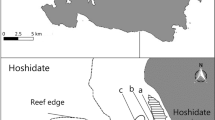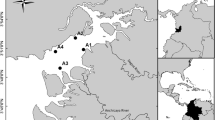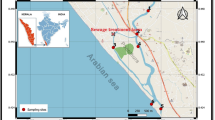Abstract
Spatial and temporal variation in the fish community structure were studied in a tropical non-estuarine embayment in Chwaka Bay, Zanzibar (Tanzania). Fish samples were collected bi-monthly (at each spring low tide) for 1 year (November 2001–October 2002) from a range of bay habitats ranging from mangroves deep inside the bay to seagrass beds close to the mouth of the bay. Additionally, environmental variables were examined to determine their relationship with the fish community structure. Being a non-estuarine embayment, the environmental variables as well as the fish community structure in each habitat remained relatively constant for most part of the year; however, a marked decline was observed during the rainy period (April–May). Significant variations in fish community variables (density, biomass and species richness) and in water temperature and salinity were observed during the rainy season in all habitats, with larger changes in the mangrove and mud/sand flats habitats than in the seagrass beds. Seasonal variations in water clarity and dissolved oxygen were not significant, though. Many species disappeared from the mangrove and mud/sand flats habitats during the rainy season and those which persisted showed a remarkable decrease in density. Moreover, the results indicate that mangroves were the preferred settling habitats for Gerres filamentosus, Gerres oyena, Lethrinus lentjan and Monodactylus argenteus, especially during the dry period (December–February) before the rainy season. This observation is contrary to what has been reported from some other tropical regions where greater abundance and species richness was observed during the rainy season. A significant relationship was found between density of fish and temperature, salinity and turbidity. Since salinity was the most conspicuously changing environmental variable with seasons, we propose that salinity, alone or in combination with low visibility and temperature, was probably the most important environmental factor structuring the fish assemblage in the mangrove and mud/sand flats habitats, particularly during the rainy season.






Similar content being viewed by others
References
Barletta, M., U. Saint-Paul, A. Barletta-Bergan, W. Ekau & D. Schories, 2000. Spatial and temporal distribution of Myrophis punctatus (Ophichthidae) and associated fish fauna in a northern Brazilian intertidal mangrove forest. Hydrobiologia 426: 65–74.
Barletta, M., A. Barletta-Bergan, U. Saint-Paul & G. Hubold, 2003. Seasonal changes in density, biomass, and diversity of estuarine fishes in tidal mangrove creeks of the lower Caeté Estuary (northern Brazilian coast, east Amazon). Marine Ecology Progress Series 256: 217–228.
Barletta, M., A. Barletta-Bergan, U. Saint-Paul & G. Hubold, 2005. The role of salinity in structuring the fish assemblages in a tropical estuary. Journal of Fish Biology 66: 45–72.
Barletta-Bergan, A., M. Barletta & U. Saint-Paul, 2002a. Community structure and temporal variability of ichthyoplankton in North Brazilian mangrove creeks. Journal of Fish Biology 61(Suppl. A): 33–51.
Barletta-Bergan, A., M. Barletta & U. Saint-Paul, 2002b. Structure and seasonal dynamics of larval fish in the Caeté River Estuary in North Brazil. Estuarine, Coastal and Shelf Science 54: 193–206.
Blaber, J. S. M., 1980. Fish of the Trinity inlet system of North Queensland with notes on the ecology of fish faunas of tropical Indo-Pacific estuaries. Australian Journal of Marine and Freshwater Research 31: 137–145.
Blaber, S. J. M., 2000. Tropical estuarine fishes. Ecology, Exploitation and Conservation. Fish and Aquatic Resources Series 7. Blackwell Science, Oxford.
Bulger, A. J., M. E. Monaco, D. M. Nelson & M. McCormick-Ray, 1993. Biologically-based estuarine salinity zones derived from a multivariate analysis. Estuaries 16: 311–322.
Cederlöf, U., L. Rydberg, M. Mgendi & O. Mwaipopo, 1995. Tidal exchange in a warm tropical lagoon: Chwaka Bay Zanzibar. Ambio 24: 458–464.
Cocheret de la Morinière, E., I. Nagelkerken, H. van der Meij & G. van der Velde, 2004. What attracts juvenile coral reef fish to mangroves: habitat complexity or shade? Marine Biology 144: 139–145.
Cyrus, D. P. & S. J. M. Blaber, 1987. The influence of turbidity on juvenile marine fishes in estuaries. Part 2. Laboratory studies, comparisons with field data and conclusions. Journal of Experimental Marine Biology and Ecology 109: 71–91.
Day, J. H., 1981. Estuarine ecology, with particular reference to southern Africa. Rotterdam, Balkema.
De Morais, T. A. & T. L. de Morais, 1994. The abundance and diversity of larval and juvenile fish in a tropical estuary. Estuaries 17: 216–225.
De Troch, M., J. Mees, I. Papadopoulos & E. O. Wakwabi, 1996. Fish communities in a tropical bay (Gazi Bay, Kenya): seagrass beds vs. unvegetated areas. Netherlands Journal of Zoology 46: 236–252.
Dickey-Collas, M., R. J. Gowen & C. J. Fox, 1996. Distribution of larval and juvenile fish in the western Irish Sea: relationship to phytoplankton, zooplankton biomass and recurrent physical features. Marine and Freshwater Research 47: 169–181.
Dorenbosch, M., M. G. G. Grol, M. J. A. Christianen, I. Nagelkerken & G. van der Velde, 2005. Indo-Pacific seagrass beds and mangroves contribute to fish density and diversity on adjacent coral reefs. Marine Ecology Progress Series 302: 63–76.
Field, A., 2000. Discovering statistics using SPSS for Windows. Sage Publications, London, p 496.
Ikejima, K., P. Tongnunui, T. Medej & T. Taniuchi, 2003. Juvenile and small fishes in a mangrove estuary in Trang province, Thailand: seasonal and habitat differences. Estuarine, Coastal and Shelf Science 56: 447–457.
Johnstone, R. W. & S. M. Mohammed, 1995. Spatial and temporal variations in water column nutrient concentrations in a tidally dominated mangrove creek: Chwaka Bay, Zanzibar. Ambio 24: 482–486.
Kimani, E. N., G. K. Mwatha, E. O. Wakwabi, J. M. Ntiba & B. K. Okoth, 1996. Fishes of a shallow tropical mangrove estuary, Gazi, Kenya. Marine and Freshwater Research 47: 857–868.
Kyewalyanga, M. N. S., 2002. Spatial-temporal changes in phytoplankton biomass and primary production in Chwaka Bay Zanzibar. Tanzania Journal of Science 28: 11–26.
Laegdsgaard, P. & C. R. Johnson, 2001. Why do juvenile fish utilise mangrove habitats? Journal of Experimental Marine Biology and Ecology 257: 229–253.
Laroche, J., E. Baran & N. B. Rasoanandrasana, 1997. Temporal patterns in a fish assemblage of a semiarid mangrove zone in Madagascar. Journal of Fish Biology 51: 3–20.
Little, M. C., P. J. Reay & S. J. Grove, 1988. The fish community of an East African mangrove creek. Journal of Fish Biology 32: 729–747.
Louis, M., C. Bouchon & Y. Bouchonnavaro, 1995. Spatial and temporal variations of mangrove fish assemblages in Martinique (French-West-Indies). Hydrobiologia 295: 275–284.
Lugendo, B. R., A. Pronker, I. Cornelissen, A. de Groene, I. Nagelkerken, M. Dorenbosch, G. van der Velde & Y. D. Mgaya, 2005. Habitat utilisation by juveniles of commercially important fish species in a marine embayment in Zanzibar, Tanzania. Aquatic Living Resources 18: 149–158.
Lugendo, B. R., I. Nagelkerken, G. van der Velde & Y. D. Mgaya, 2006. The importance of mangroves, mud and sand flats, and seagrass beds as feeding areas for juvenile fishes in Chunka Bay, Zanzibar: gut content and stable isotope analyses. Journal of Fish Biology 69: 1639−1661.
Lugendo, B. R., I. Nagelkerken, N. Jiddawi, Y. D. Mgaya & G. van der Velde, 2006, in revision. Fish community composition of a tropical non-estuarine embayment in Zanzibar, Tanzania Fisheries Science.
McClanahan, T. R., 1988. Seasonality in East Africa’s coastal waters. Marine Ecology Progress Series 44: 191–199.
Mohammed, S. M., R. W. Johnstone, B. Widen & E. Jordelius, 1995. The Role of Mangroves in the Nutrient Cycling and Productivity of Adjacent Seagrass Communities, Chwaka Bay, Zanzibar. Zoology Department, Stockholm University, Sweden, and University of Dar es Salaam, Tanzania Fisheries Science.
Mohammed, S. M. & R. W. Johnstone, 2002. Porewater nutrient profiles and nutrient sediment-water exchange in a tropical mangrove waterway, Mapopwe Creek, Chwaka Bay, Zanzibar. African Journal of Ecology 40: 172–178.
Nagelkerken, I., M. Dorenbosch, W. C. E. P. Verberk, E. Cocheret de la Morinière & G. van der Velde, 2000. Day-night shifts of fishes between shallow-water biotopes of a Caribbean bay, with emphasis on the nocturnal feeding of Haemulidae and Lutjanidae. Marine Ecology Progress Series 194: 55–64.
Nagelkerken, I. & G. van der Velde, 2002. Do non-estuarine mangroves harbour higher densities of juvenile fish than adjacent shallow-water and coral reef habitats in Curaçao (Netherlands Antilles)? Marine Ecology Progress Series 245: 191–204.
Parrish, J. D., 1989. Fish communities of interacting shallow-water habitats in tropical oceanic regions. Marine Ecology Progress Series 58: 143–160.
Robertson, A. I. & N. C. Duke, 1987. Recruitment, growth and residence time of fishes in a tropical Australian mangrove system. Estuarine, Coastal and Shelf Science 31: 723–743.
Robertson, A. I. & N. C. Duke, 1990. Mangrove fish communities in tropical Queensland, Australia – Spatial and temporal patterns in densities, biomass and community structure. Marine Biology 104: 369–379.
Robertson, A. I. & S. J. M. Blaber, 1992. Plankton, epibenthos and fish communities. In Robertson A. I. & D. M. Alongi (eds), Tropical Mangrove Ecosystems. Coastal and Estuarine Studies 41: 173–224.
Stoner, A. W., 1986. Community structure of the demersal fish species of Laguna Joyuda, Puerto Rico. Estuaries 9: 142–152.
Strydom, N. A. & B. D. d’Hotman, 2005. Estuary-dependence of larval fishes in a non-estuary associated South African surf zone: evidence for continuity of surf assemblages. Estuarine, Coastal and Shelf Science 63: 101–108.
ter Braak, C. J. F. & P. Smilauer, 1998. Reference manual and user’s guide to Canoco for Windows: Software for canonical community ordination (version 4). Microcomputer Power, Ithaca, New York.
Tzeng, W. & Y. Wang, 1992. Structure, composition and seasonal dynamics of the larval and juvenile fish community in the mangrove estuary of Tanshui River, Taiwan. Marine Biology 113: 481–490.
Tzeng, W. N., Y. T. Wang & C. W. Chang, 2002. Spatial and temporal variations of the estuarine larval fish community on the west coast of Taiwan. Marine and Freshwater Research 53: 419–430.
van der Velde, G., P. H. van Avesaath, M. J. Ntiba, G. K. Mwatha, S. Marguillier & A. F. Woitchik, 1995a. Fish fauna of mangrove creeks, seagrass meadows and sand flats in Gazi Bay, Kenya (Indian Ocean): a study with nets and stable isotopes. In Heip, C. H. R., M. A. Hemminga & M. J. M. de Bie (eds.), Monsoons and Coastal Ecosystems in Kenya. Netherlands Indian Ocean Programme Cruise Report 5: 39–50.
van der Velde, G., F. Dehairs, S. Marguillier, G. K. Mwatha, R. L. J. M. Op ‘t Veld, S. Rajagopal & P. H. van Avesaath, 1995b. Structural and stable isotope differences in the fish communities of mangrove creeks, seagrass meadows and sand flats in Gazi Bay (Kenya). In Hemminga, M. A. (ed.), Interlinkages Between Eastern-African Coastal Ecosystems. STD-III project. Final report. 132–157.
Verweij, M. C., I. Nagelkerken, D. de Graaff, M. Peeters, E. J. Bakker & G. van der Velde, 2006. Structure, food and shade attract juvenile coral reef fish to mangrove and seagrass habitats: a field experiment. Marine Ecology Progress Series 306: 257–268.
Vidy, G., 2000. Estuarine and mangrove systems and the nursery concept: which is which? The case of Sine Saloum system (Senegal). Wetland Ecology and Management 8: 37–51.
Weerts, S. P. & D. P. Cyrus, 2002. Occurrence of young and small-sized fishes in different habitats within a subtropical South African and adjacent harbour. Marine and Freshwater Research 53: 447–456.
Whitfield, A. K., 1994. Abundance of larval and 0+ juvenile marine fishes in the lower reaches of three southern African estuaries with differing freshwater inputs. Marine Ecology Progress Series 105: 257–267.
Yáñez-Arancibia, A., A. L. Lara-Domínguez, J. L. Rojas Galaviz, P. Sánchez-Gil, J. W. Day & C. Madden, 1988. Seasonal biomass and diversity of estuarine fishes coupled with tropical habitat heterogeneity (southern Gulf of Mexico). Journal of Fish Biology 33: 191–200.
Acknowledgements
Field assistance was provided by M.A. Manzi, S.J. Simgeni and M.A. Makame. The administration and staff of the Institute of Marine Sciences (IMS) in Zanzibar provided logistical support and research facilities. This study was financially supported by NUFFIC through the ENVIRONS-MHO Project. A.P., A.G. and I.C. were funded by the Schure-Beijerinck-Popping Foundation and Quo Vadis Fonds (Radboud University Nijmegen), The Netherlands. I.N. was supported by a VIDI grant from the Netherlands Organisation for Scientific Research (NWO). This is Centre for Wetland Studies publication no. 413.
Author information
Authors and Affiliations
Corresponding author
Additional information
Handling editor: J. A. Cambray
Electronic supplementary material
Below are the electronic supplementary materials.
Rights and permissions
About this article
Cite this article
Lugendo, B.R., de Groene, A., Cornelissen, I. et al. Spatial and temporal variation in fish community structure of a marine embayment in Zanzibar, Tanzania. Hydrobiologia 586, 1–16 (2007). https://doi.org/10.1007/s10750-006-0398-3
Received:
Revised:
Accepted:
Published:
Issue Date:
DOI: https://doi.org/10.1007/s10750-006-0398-3




